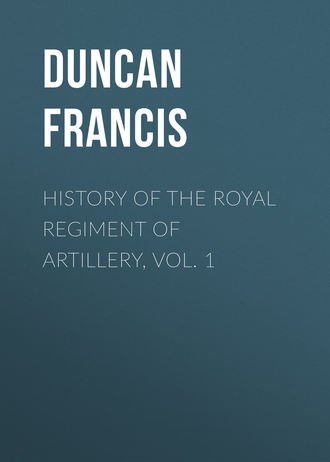 полная версия
полная версияHistory of the Royal Regiment of Artillery, Vol. 1
There is a little obscurity as to the services of this battalion during the American War of Independence. One set of documents claims for Nos. 1 and 6 Companies, no inconsiderable share in the earlier part of the campaign; another asserts that to the 4th Battalion alone does all the credit, which the Artillery during that war especially merited, belong. The truth seems to be, that, in 1778, two companies of the 3rd Battalion were in America, and were engaged in several battles; but that in 1779, the men of these companies were drafted into those of the 4th Battalion, and their officers returned to England.
The fusion was not, however, complete; for we find traces of No. 1 Company of the 3rd Battalion in America so late as 1781, when a detachment of it was present at Guildford Court-house.
No fewer than seven companies of the battalion were engaged in the West Indies in the last decade of the eighteenth century; five companies served in the Peninsula, four being present at the Battle of Corunna; eight companies served on the Walcheren expedition; and four companies – Nos. 2, 4, 7, 9 – were present at the Battle of Waterloo. At this battle detachments of Nos. 5 and 6 Companies were also present.
At the commencement of the Crimean war, although the strength of the battalion was considerable, it only consisted of eight companies, two having been reduced in 1819; and of these eight, no fewer than six took part in the war.
Appended is a list – as in the case of the 1st and 2nd Battalions – showing, in anticipation, the various military operations in which the companies of the 3rd Battalion were engaged – the succession of Captains, as far as can be traced down to 1859 – and the nomenclature introduced in that year, when Battalions and Companies became Brigades and Batteries.
No. 1 COMPANY, 3rd BATTALION,
Now "A" BATTERY, 4th BRIGADE.
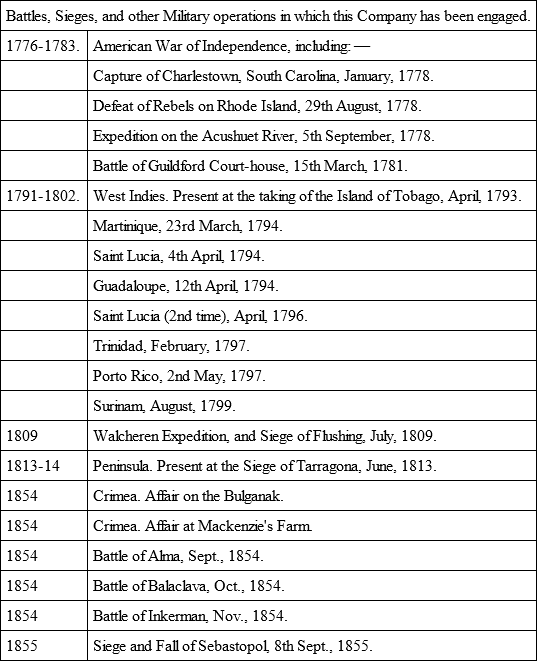
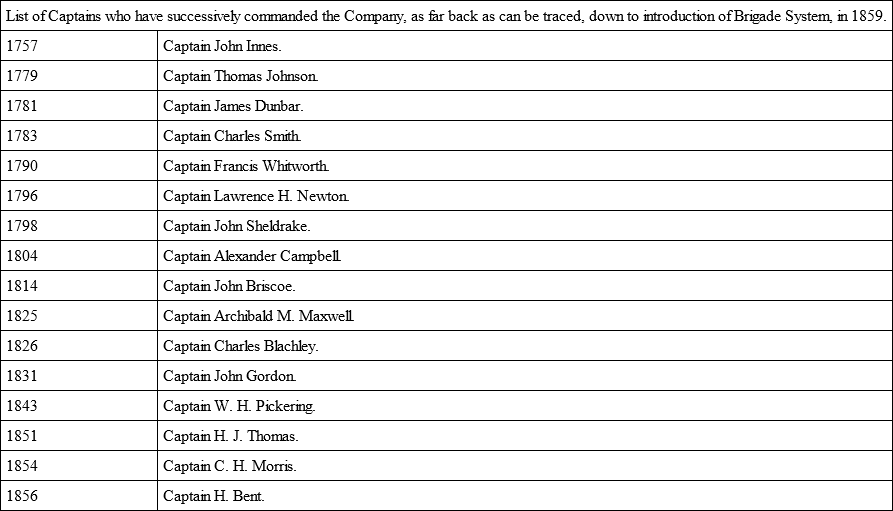
No. 2 COMPANY, 3rd BATTALION,
Now "7" BATTERY, 13th BRIGADE.
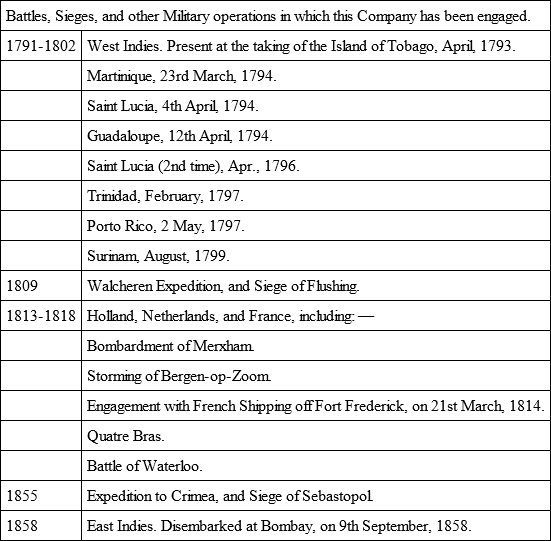
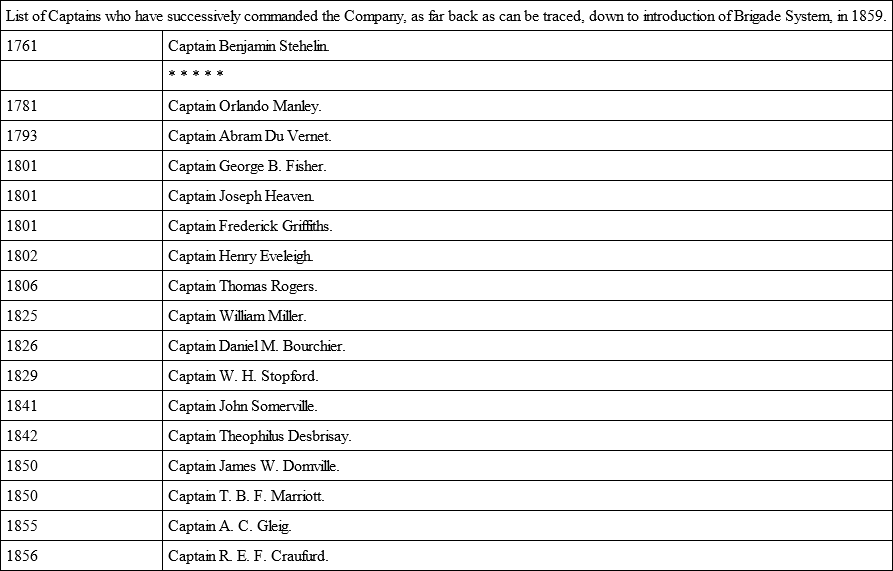
No. 3 COMPANY, 3rd BATTALION,
Now "2" BATTERY, 13th BRIGADE.
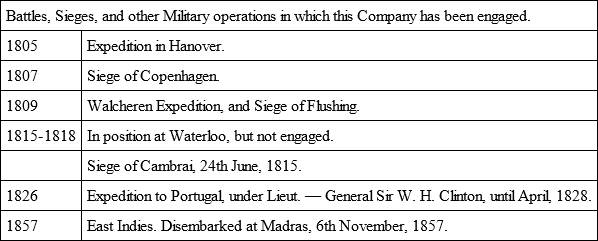
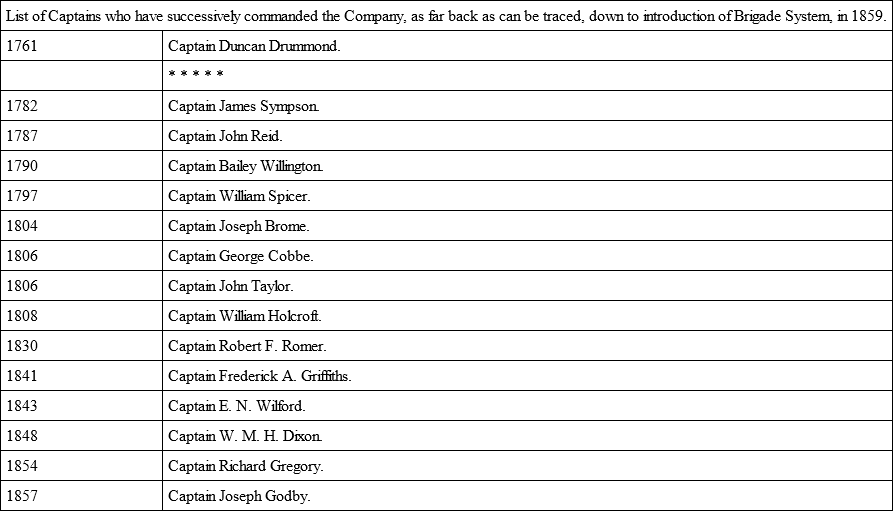
No. 4 COMPANY, 3rd BATTALION,
Now "4" BATTERY, 3rd BRIGADE.
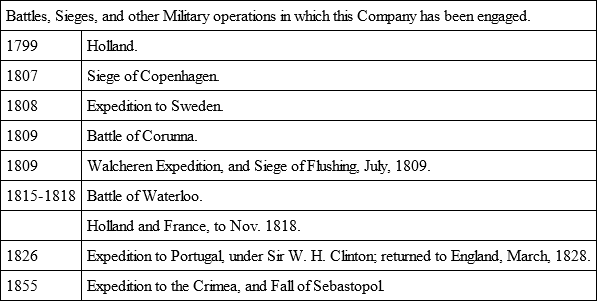
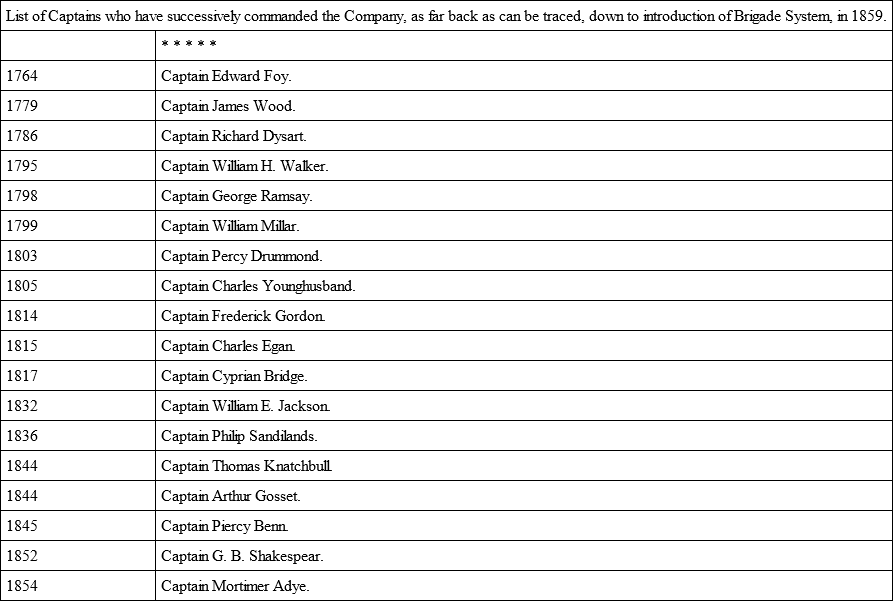
No. 5 COMPANY, 3rd BATTALION,
Now "B" BATTERY, 11th BRIGADE.
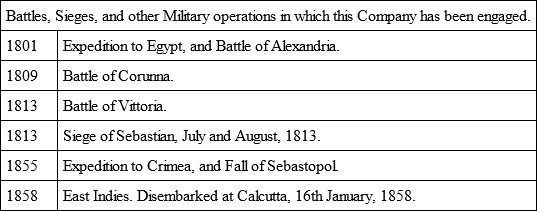
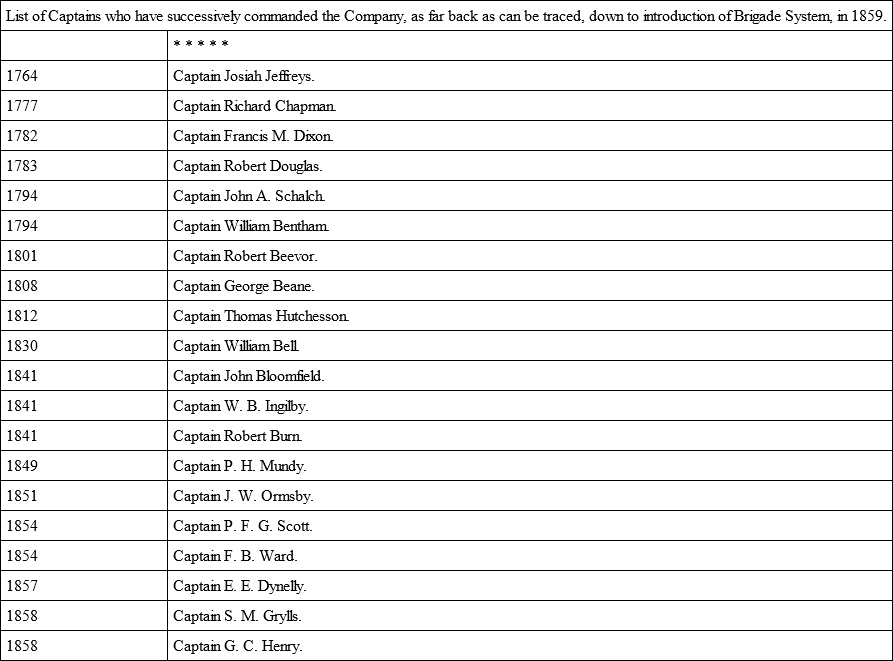
No. 6 COMPANY, 3rd BATTALION,
Now "7" BATTERY, 3rd BRIGADE.
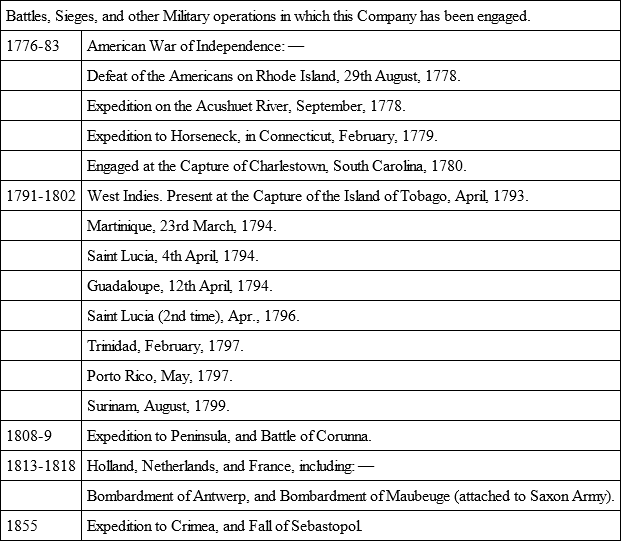
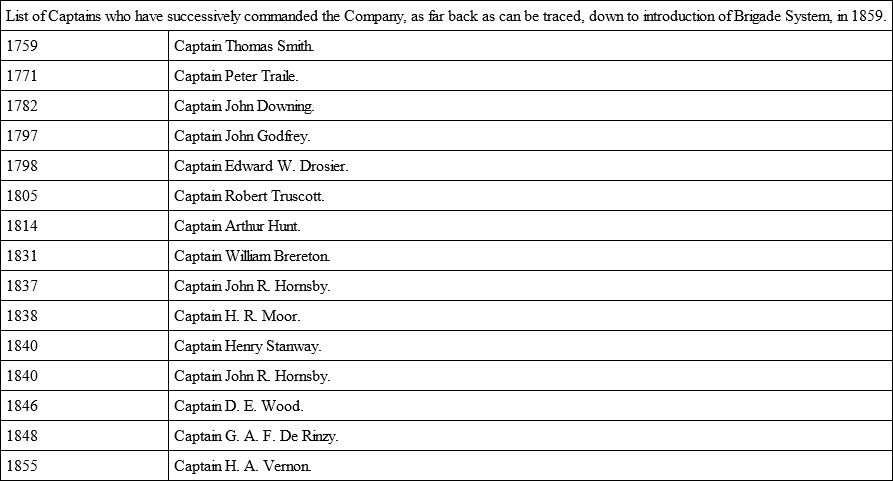
No. 7 COMPANY, 3rd BATTALION,
Now "3" BATTERY, 7th BRIGADE.
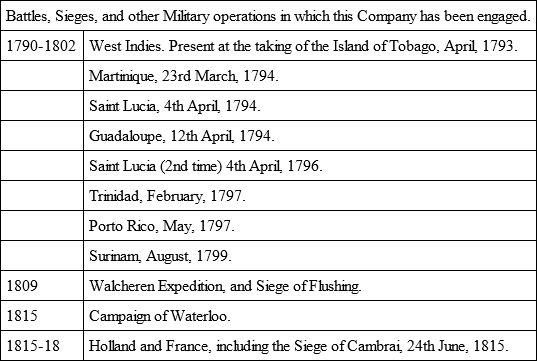
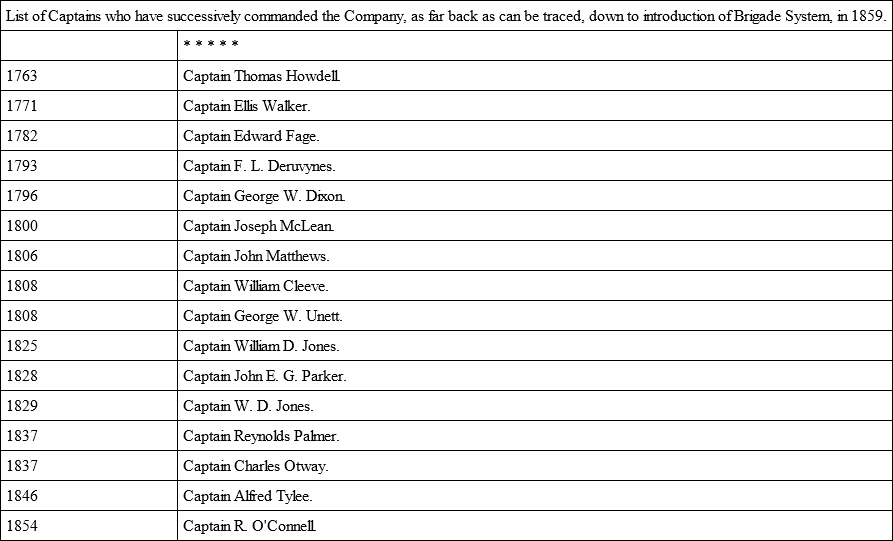
No. 8 COMPANY, 3rd BATTALION,
Now "D" BATTERY, 4th BRIGADE.
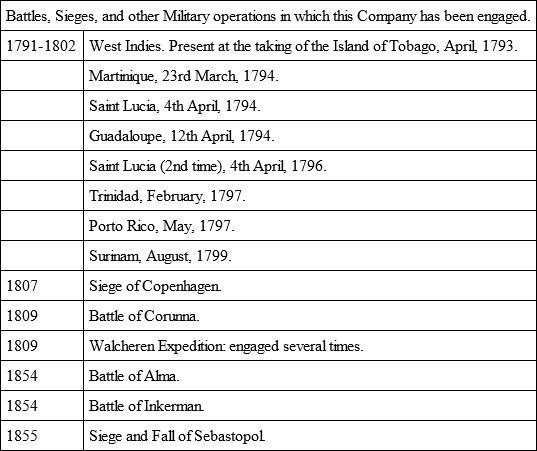
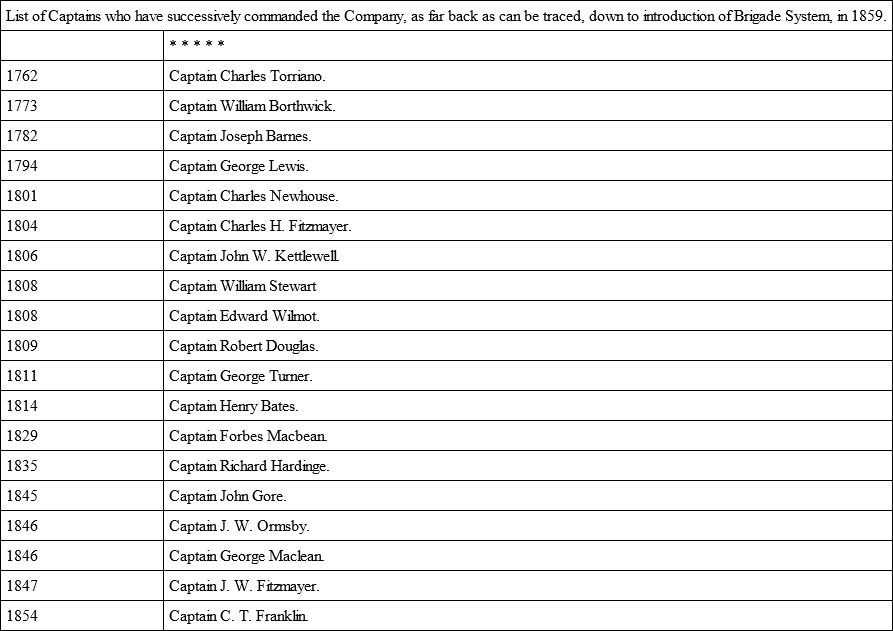
No. 9 COMPANY, 3rd BATTALION,
Reduced 1819.
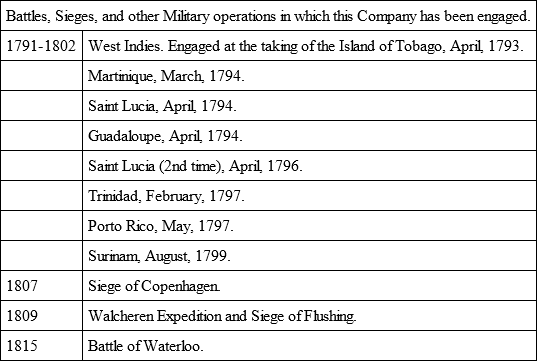
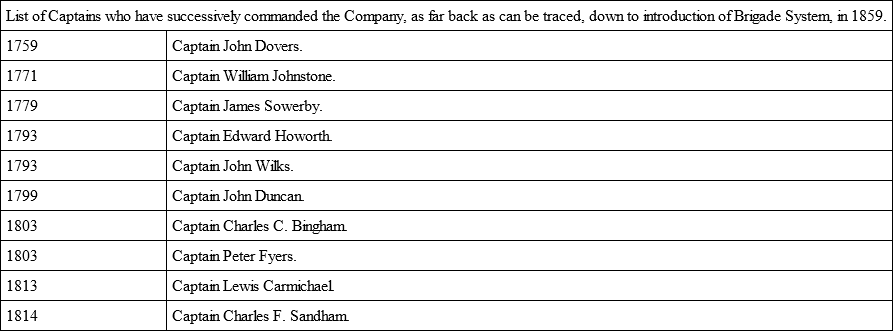
No. 1 °COMPANY, 3rd BATTALION,
Reduced 1819.
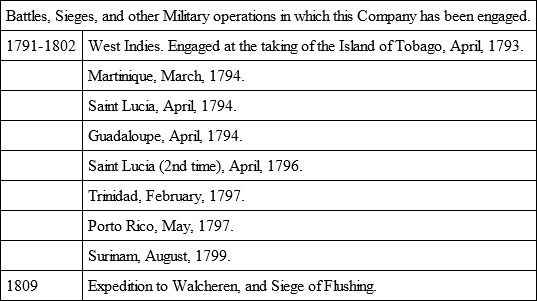
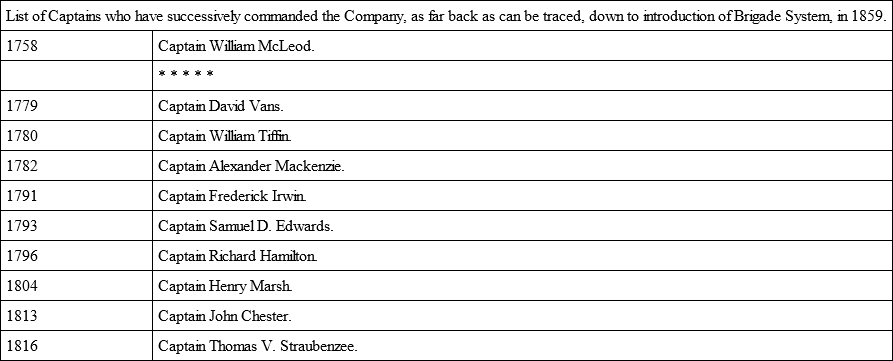
CHAPTER XXI.
The Siege of Belleisle
Although the History of the Royal Artillery is the history of England's campaigns since the existence of the Regiment, there are occasional chapters in these wars more interesting to the Artilleryman, than to the ordinary military student, or the general reader. There have been events which have had no perceptible effect on the progress of the campaigns, and yet are indissolubly woven in our Regimental annals. Of such events the siege of Belleisle is a type.
During the Seven Years' War, England made various diversions – in addition to those in America and the East Indies – to distract the French in their operations against the Allied Army in Germany. One of these was the attack on the Island of Belleisle on the west coast of France, between Port Louis and the mouth of the Loire. It was devised in the hope of inducing the French to detach some of their forces from Germany, for the defence of their own coasts; but in this respect it failed. Another motive, which inspired the English Government, was that they might gratify the lust for conquest, which at that time animated the people, whetted instead of satiated by their successes in the East and in the West.
To a certain extent, it succeeded in this; but after counting the cost of the victory, it required the most exaggerated statements on the part of the Ministry to reconcile the nation to the expenditure of life and money caused by the Siege of Belleisle, if indeed it can be said ever to have been reconciled.
The English nation has characteristics, which are displayed at every stage of its history. Lavish during war in order to gain its ends, it is disposed to be penurious during peace; and the favourite stalking-horse to power then is a profession of economy. The whole of Europe stood amazed at the readiness with which the English nation granted enormous supplies for the carrying on of the war ending in 1762; and this had perhaps as much effect as military success in persuading the French to consent to the disastrous conditions of the Peace of Paris. It may be said that, as a nation, the English sink political differences during war, and show a union almost peculiar to themselves. The only case in which war and political differences existed simultaneously to any great extent was during the American War of Independence; the reasons then were exceptional, and the result fatal.
As a consequence of political union, comes a demand for vigorous administration; and the success of Mr. Pitt's ministry was due to his knowledge of this. The Siege of Belleisle was an illustration of this knowledge. It cannot be said that in time of peace the English insist on such administrative vigour; in fact, vigorous action in the head of a department is viewed with distrust and suspicion more frequently than with admiration. It is by remembering considerations such as these that a military operation such as is now to be described can be understood, almost valueless in its political results, expensive in its conduct, and – in a military point of view – worthless, save in so far as it strengthened (as only success can do) the esprit and courage of the Army.
But to the Artilleryman this siege has an interest far above political considerations; it was one of the earliest schools for developing that which is the most scientific, albeit less brilliant branch of the Regiment, – Siege Artillery. And it was suitable that the man who commanded the siege-train on this occasion should be one eminent afterwards in the scientific as well as the military world: a Fellow of the Royal Society as well as a practical soldier: a fit predecessor to the many who have since distinguished the Regiment by their learning – Brigadier Desaguliers.
The Artillery present at the siege consisted of two companies from Portsmouth, Captain Tovey's and Captain Hind's, with about seventy miners; besides eleven detachments for battalion guns, and others for service on board the bomb-vessels.
There were no less than thirty-seven Artillery officers employed in the expedition. Of these, Captain-Lieutenant Muckell was killed, and the following were wounded: Brigadier Desaguliers, Lieutenant N. Kindersley, – the Acting Adjutant, Lieutenant E. Williams, and Lieutenant-Fireworker A. McKenzie. The following is a list of the officers who did duty in the trenches, in addition to those named above: —
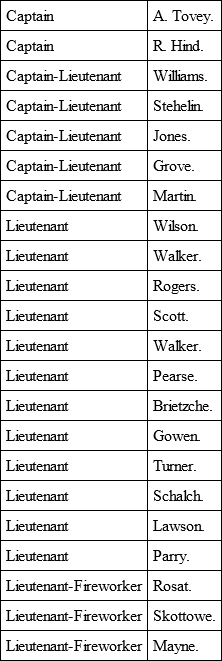
There were also two medical officers attached to the Artillery.
When, in the early part of 1761, preparations for an expedition on a large scale were commenced at Portsmouth, it was imagined that the destination of the fleet was either the East or West Indies. The vessels were provisioned for twelve months; there were no less than 35 transports; and the only difficulty that spectators and gossips had to overcome was the fact that an immense number of flat-bottomed boats, capable each of carrying 60 men, was to form part of the fleet. Those were days when newspaper reporters and interviewers were not licensed as now; and when inquisitive members of Parliament had to content themselves with very evasive replies.
In addition to a powerful fleet and Artillery, no less than fifteen battalions of infantry and three troops of Burgoyne's horse accompanied the expedition. The command of the troops was given to Major-General Studholm Hodgson, with several Brigadiers to assist him, some of whom bore names which we shall meet again during the War of Independence, Howe, Burgoyne, and Carleton. The fleet was under the command of Commodore Keppel; and it was intended that much of the work should be done by it, as the nation had of late been somewhat outspoken as to the inaction of the navy, nor were Admiral Byng and Minorca forgotten.
When the fleet first sailed from Portsmouth on the 29th March, 1761, Captain Tovey commanded the Artillery; but on the 5th April Colonel Desaguliers was ordered by the King to proceed (with the rank of Brigadier) to Portsmouth: the miners were ordered to the same place to join Captain Hind's company; the whole to proceed without delay to Belleisle, whither it was now known the expedition had gone. The gallant Brigadier was no sluggard; at midnight on the 6th April – those were not the days of railways – he reached Portsmouth, sent word to Captain Hind to have his company ready at a moment's notice, went himself on board the 'Blast' transport on the afternoon of the 7th, and sailed at daybreak the following morning.
The same energy displayed itself on his reaching Belleisle. The expedition had already met with misfortune. An attempt had been made on the 8th April to land 300 men on the south-east of the island, after a heavy and apparently successful bombardment from the fleet; but the enemy charged them with superior numbers before they could form, and took them all prisoners, besides inflicting a loss on some detachments which landed to assist them, of 37 killed and 76 wounded.
A heavy gale followed, in which 20 boats were lost and many vessels driven to sea; the introduction to a continuation of frightful weather which lasted during the whole siege. On the 12th April, Brigadier Desaguliers arrived; learnt what had taken place; immediately ordered the battalion guns to be placed in the Ordnance boats, – ready to accompany the troops on the next attempt at a landing, coming into action so as to enable the infantry to form up on the shore; got his warrant as commanding the Royal Artillery published in orders; appointed Captain-Lieutenant Stehelin his Brigade Major; and volunteered to reconnoitre the island for a landing-place.
On the 22nd, Captain Hind's company, with the miners, some other troops, and an immense quantity of Artillery stores, reached Belleisle. It had by this time been resolved to attempt a landing near the place, where the first had failed; but with a view to deceiving the enemy, the newly-arrived troops were ordered to get into the ship's boats, and make a feint of landing at the Point of Sauzon. The feint succeeded; the fear of their landing detained a large body of the enemy whose presence would have been invaluable in checking the real landing, which was now effected, under cover of the fire from the fleet, and assisted by the panic which was created among the enemy by the appearance on their flank of a number of men who had climbed up some difficult precipices, at a little distance from the spot where the main body landed.
In addition to a body of 900 marines, which landed with the other troops, the Commodore collected 500 from the ships, and landed them; and as the Colonel of the Marines, McKenzie, had been wounded, the command of this large body devolved upon a Captain named Collins, who on account of the responsibility of his position received the rank of Major.
For some days the weather was so tempestuous that it was impossible to land the heavy guns, or Artillery stores; and the enemy was enabled to strengthen his position unmolested. The bomb-vessels stood close in to the shore, and plied the Citadel, but without much effect. Picquets of 500 men were on duty every night in the English camp; the inhabitants of Palais, the capital of the Island, were strictly watched; and a village in a good position was taken and set fire to, from which circumstance it was always after this time called "the Burnt Village." The Artillerymen were hard at work making their batteries and parallels, assisted by large working parties from the Line; and every officer in the Army who knew anything of engineering was invited to submit his name with a view to employment at an increased rate of pay. The trench work was not a favourite duty with the infantry, even after working-pay was allowed for it; and Brigadier Desaguliers had to make the strongest representations on the subject to General Hodgson. The men did not dislike idling and loafing about the trenches; it was the spade-work which was unpopular; and this led to an amusing order being issued, that any Artillery officer who found a man near his post, idling or curious, was to "lay hold of him, and make him work for 12 hours."
The town of Palais was soon occupied by the English troops, and being near the Citadel, to which the enemy had withdrawn, it afforded excellent cover for the English marksmen, whom the reluctance of the enemy to fire on the town left quite unmolested.
The armament for the batteries had at length been landed and mounted, although not without the greatest difficulty. The Brigadier had at this time, and later on, repeatedly to acknowledge the assistance he received from the Navy, between which and the Artillery there was then, as now, a strong entente cordiale.
And now commenced the regular siege: – Sebastopol in miniature; daily and nightly bombardments; the trenches flooded with rain; and Artillerymen so reduced in numbers as to be without the requisite rest or relief. Three important batteries were opened against the Citadel, known respectively as the 16-Gun, the 10-Gun, and the 4-Gun Batteries. Mortar batteries were made, as the siege progressed, containing two 13-inch, three 10-inch, and six 8-inch land-service mortars; two 13-inch, and two 10-inch sea-service mortars; besides fifteen Royal mortars, and ten Coe-horn's. The guns in the batteries were heavy 24-pounders, medium 12-pounders, and 8-inch and 4½-inch howitzers. There were a few 3-pounder guns, and the Battalion guns, which were 6-pounders. Although it is somewhat anticipating matters, it may here be mentioned that the expenditure of ammunition by the Artillery during the siege amounted to 1500 barrels of powder, 17,000 shot, and 12,000 shell.
The infantry had been divided into three brigades, with a total of all ranks of 6254, exclusive of Artillery, Marines, and Burgoyne's horse, the last-named being chiefly employed in duties of transport and foraging. The duties, which were very heavy, were taken alternately by brigades. The marines did duty in corps, and had to find 378 men for various guards every day.
When Palais was taken, the bells of the churches became, according to custom, the property of the commanding officer of Artillery. A piteous letter, however, was written to him by the priests, pleading the poverty of their parishes, the destitution of many members of their congregations, and the precarious livelihood earned by the most fortunate, concluding by offering 300 livres in ransom for their bells. "So miserable and wretched," wrote the Rector of Palais, was his parish since the bombardment – more so even than before, when no repairs could be executed without the assistance of private charity, that the Church would be unable to exist, did the Commandant of Artillery act on his rights with rigour." They therefore prayed him to leave the bells untouched, that the services might be notified to the people; and to suffer them to be redeemed by the sum above mentioned: with which request Brigadier Desaguliers complied.
Various interesting occurrences took place early in the siege. On the 2nd May, some guns under cavalry escort were ordered to occupy a village on the left of the English camp, which had given considerable annoyance. So warm, however, was their reception, that the cavalry withdrew, with some precipitation. The guns pressed on, nevertheless, unsupported, for about 700 yards, cannonaded the village, and dislodged the enemy. Artillery in a village, without escort, was a strong temptation; and towards night, 300 men made an attempt to cut them off from the main body. The gunners were awake, withdrew their guns behind some rising ground about 1450 yards from the Citadel, and kept their assailants at bay. Next morning, General Hodgson visited the spot, and was so charmed with its natural advantages that he ordered it to be entrenched, and strong batteries mounted. The same was done at this time in front of the Burnt Village, about 900 yards from the Citadel.
The enemy did not content himself with answering the English cannonade. Sorties were frequent; and on one dark night, Major-General Crawford and his staff, taken unawares, were made prisoners in the trenches. Many more would have met the same fate, but for the presence of mind of the gunners in charge of two light field-pieces which happened to be in the trenches that evening. They were charged by several hundred men, including a spiking party, but with well-aimed and frequent volleys of grape, the gunners utterly routed them.
The fire of the enemy was by no means contemptible; in fact, until a number of their guns were dismounted, it was both admirable and effective. On one occasion, a sergeant and thirteen men in the trenches were killed by the explosion of one of the enemy's shells; and so numerous at last were the casualties among the Artillery, that the Brigadier had to apply for 200 men from the infantry to assist in working the guns. There was great difficulty in obtaining even that number: the duties of the camp were hard; and the importance of keeping the Artillery ranks at a siege well filled was not yet fully understood. But with the progress of the siege, came an increase of wisdom; and, before long, not a requisition from the Brigadier was unattended to.
All the available sea-service mortars had been landed from the ships; but a few vessels of lighter draught stood in to attack the Citadel from the sea with their guns. The effect produced was but slight, perhaps because – as an old diary of the siege says – "There were no Artillery people, either officers or men, aboard."
The English works were gradually approached to within musketry range of the Citadel; and to enable the working parties to carry on their duties without molestation from the enemy's marksmen, a heavy and somewhat wasteful fire was kept up from the batteries, which had at length to be put a stop to by the Brigadier, for reasons of economy.
That the fire of the English Artillery was effective, was ascertained from prisoners, who said, "Que c'étoit un feu infernal, et qu'on ne voyoit ni ciel, ni terre;" and, when on parole in the town of Palais, a favourite joke among the French prisoners, when they saw an Artillery officer approaching, was to run behind the nearest cover, shouting "Gare la bombe! Gare la bombe!"
When the second parallel was opened, the Navy commenced landing some 32-pounders to arm a battery which some amateur engineers had made, and as additional mortar batteries had also been constructed, the works were now so extensive, that the Artillery was utterly unable to man them all. General Hodgson, accordingly, issued a standing order that as many men from the infantry as Brigadier Desaguliers should require were to be given, and while employed with the Artillery, their pay and allowances were to be made equal to those of the matrosses.
After the occupation of Palais by the British troops, much trouble was caused by drunkenness among the men, and its concomitants, absence and insubordination. The Provost-Marshal was at last ordered to live there, and got very extensive powers. Inter alia, he was permitted "to hang any soldiers committing any kind of irregularities; above all to lay hold of any soldier whom he found drunk on duty, and when he became sober to hang him without trial."
When the civil officials of Palais had occasion to come into the trenches on business, they were always blindfolded while there. Their business was generally of a commercial nature: they were ready to accept English money for their wares, but were anxious to be the appraisers of the value of the foreign coins. At last, it was necessary to publish in orders a standard, regulating the comparative values of French and English specie, – the guinea being valued at 24 livres; and if any tradesman was found cheating in this respect, he was made liable to confiscation of his goods, and corporal punishment.
As the siege approached its end, many of the redoubts near the Citadel fell into the hands of the British; and the duties of the officers of Artillery became somewhat lighter. It is pleasant to find that, instead of availing themselves of their comparative leisure, they all immediately offered their services as engineers, an offer which was greedily accepted.
The Ordnance stores were sadly reduced, and the Navy had not another round to spare; so that fresh requisitions had to be sent to England more than once. Pending a reply, a very strict economy was enjoined; firing in volleys was forbidden, and single rounds were directed to be fired day and night at stated intervals. Twenty-four rounds per gun was laid down as the daily maximum; but an exception was permitted, should the Citadel seem to be on fire, in which case even volleys were allowed. Even to the end, when the number of available guns in the Citadel was much reduced, the fire of the enemy was excellent; twice the English magazines were blown up, and only five days before the capitulation a most severe loss was inflicted on the besiegers, Brigadier Desaguliers himself being among the wounded.
The enemy was able by means of subterranean passages and signalling to keep up a constant communication with the mainland. Nor did he confine himself to these. An apparently innocent and respectable old lady was found traversing the English lines one morning under suspicious circumstances. She was questioned without success. Her profession – she said – was simple; she was a washerwoman, and in the exercise of her vocation had she been seized. A stronger measure was taken: the old lady was searched. Her countenance fell as the operation commenced; fell yet more as dozens of letters were produced from hidden places, containing piteous appeals for assistance from the beleaguered citizens. But even yet she protested her innocence, her astonishment, and her trade; and, yet protesting, with a rope round her neck, she was led away. Whether the rope was afterwards tightened or not, the story does not tell.



